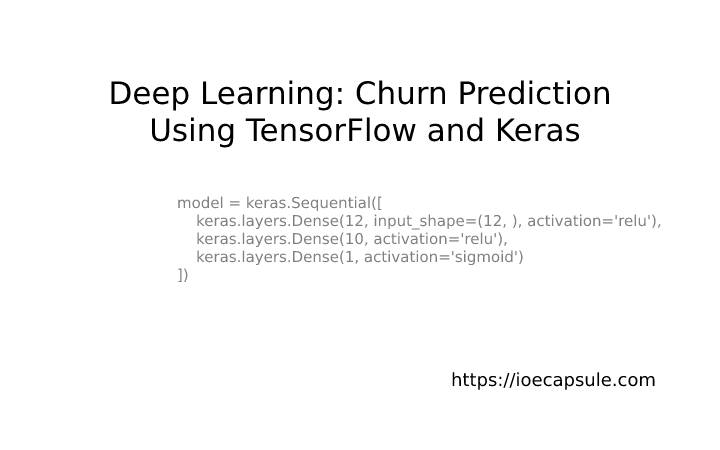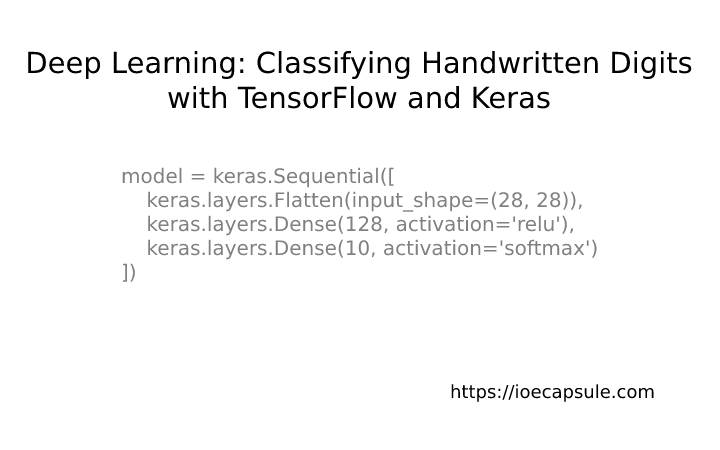Deep Learning: Detecting Clothing Items with TensorFlow and Keras
Clothing item detection is an important task in the fashion industry. With the rise of e-commerce and online shopping, being able to accurately detect clothing items in images is crucial for creating a seamless shopping experience. In this article, we will explore how to build a clothing item detection system using TensorFlow and Keras, two popular open-source libraries for machine learning and deep learning.
The first step in building a clothing item detection system is to gather a dataset of images that contains clothing items. For our system, we will be using the Fashion-MNIST dataset, which contains 70,000 grayscale images of clothing items such as t-shirts, trousers, dresses, and bags, divided into 60,000 training images and 10,000 test images.
Next, we will build our model using TensorFlow and Keras. Our model will be a Convolutional Neural Network (CNN), a type of deep learning model that is particularly well-suited for image classification tasks. The CNN will take an image as input and output a prediction for the clothing item it contains.
To train the model, we will first need to preprocess the data. This involves converting the images to a numerical representation that can be fed into the model, and one-hot encoding the labels to represent the different clothing items. We will then compile the model and fit it to the training data, using a categorical cross-entropy loss function and an optimizer such as the stochastic gradient descent (SGD) algorithm.
Once the model has been trained, we can evaluate its performance on the test data. This involves using the model to make predictions on the test images and comparing the predictions to the actual labels. We can use metrics such as accuracy and F1-score to evaluate the performance of the model.
Finally, we can use the trained model to detect clothing items in new images. This can be done by simply passing an image through the model and getting the predicted label. With TensorFlow and Keras, we can easily deploy the model in a web or mobile application, making it possible for users to quickly identify clothing items in real-time.
A very simple implementation of fashion item detection using tensorflow and keras is as follows:
import tensorflow as tf
from tensorflow import keras
# Load the Fashion-MNIST dataset
(x_train, y_train), (x_test, y_test) = keras.datasets.fashion_mnist.load_data()
# Preprocess the data
x_train = x_train.reshape(-1, 28, 28, 1) / 255.0
x_test = x_test.reshape(-1, 28, 28, 1) / 255.0
y_train = keras.utils.to_categorical(y_train, 10)
y_test = keras.utils.to_categorical(y_test, 10)
# Build the model
model = keras.Sequential([
keras.layers.Conv2D(32, (3, 3), activation='relu', input_shape=(28, 28, 1)),
keras.layers.MaxPooling2D((2, 2)),
keras.layers.Conv2D(64, (3, 3), activation='relu'),
keras.layers.MaxPooling2D((2, 2)),
keras.layers.Flatten(),
keras.layers.Dropout(0.5),
keras.layers.Dense(128, activation='relu'),
keras.layers.Dense(10, activation='softmax')
])
# Compile the model
model.compile(optimizer='adam',
loss='categorical_crossentropy',
metrics=['accuracy'])
# Train the model
model.fit(x_train, y_train, epochs=10, batch_size=32)
# Evaluate the model
test_loss, test_acc = model.evaluate(x_test, y_test)
print('Test accuracy:', test_acc)
# Use the model to make predictions
predictions = model.predict(x_test)
This code uses the Fashion-MNIST dataset to train a simple convolutional neural network (CNN) for clothing item detection. The model consists of several convolutional and pooling layers, followed by a dense layer for making the final predictions. The model is compiled with the adam optimizer and the categorical_crossentropy loss function, and then trained for 10 epochs with a batch size of 32. Finally, the model’s performance is evaluated on the test data and its accuracy is printed.
In conclusion, TensorFlow and Keras make it easy to build a clothing item detection system. With a few lines of code, we can train a deep learning model that can accurately detect clothing items in images. This technology has the potential to revolutionize the fashion industry and make shopping for clothing items faster and more convenient for consumers.
If you prefer github, you may find the jupyter notebook file from following link.













